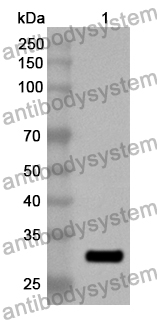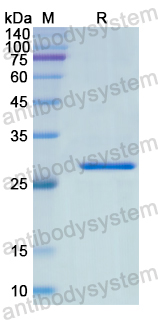Catalog No.
PHJ97401
Species reactivity
Human, Mouse, Rat
Host species
Rabbit
Isotype
IgG
Clonality
Polyclonal
Immunogen
E. coli - derived recombinant Human ACSL5 (Arg432-Asp683).
Tested applications
ELISA: 1:4000-1:8000, IHC: 1:50-1:100, WB: 1:1000-1:4000
Target
Long-chain acyl-CoA synthetase 5, Long-chain-fatty-acid--CoA ligase 5, ACSL5, FACL5, LACS 5, Arachidonate--CoA ligase, ACS5
Purification
Purified by antigen affinity column.
Accession
Q9ULC5
Applications
ELISA, IHC, WB
Form
Liquid
Storage buffer
0.01M PBS, pH 7.4, 50% Glycerol, 0.05% Proclin 300.
Stability and Storage
Use a manual defrost freezer and avoid repeated freeze thaw cycles. Store at 2 to 8°C for frequent use. Store at -20 to -80°C for twelve months from the date of receipt.
Obesity enhances the response to neoadjuvant anti-PD1 therapy in oral tongue squamous cell carcinoma., PMID:38923758
Lipid-induced up-regulation of human acyl-CoA synthetase 5 promotes hepatocellular apoptosis., PMID:20470896
Acyl-CoA synthetase as a cancer survival factor: its inhibition enhances the efficacy of etoposide., PMID:19459852
Expression of acyl-CoA synthetase 5 reflects the state of villus architecture in human small intestine., PMID:14743501
Impaired expression of acyl-CoA-synthetase 5 in epithelial tumors of the small intestine., PMID:14608540
Rat liver acyl-CoA synthetase 4 is a peripheral-membrane protein located in two distinct subcellular organelles, peroxisomes, and mitochondrial-associated membrane., PMID:12147264
Acyl-CoA synthetase isoforms 1, 4, and 5 are present in different subcellular membranes in rat liver and can be inhibited independently., PMID:11319232
Fatty acid induced glioma cell growth is mediated by the acyl-CoA synthetase 5 gene located on chromosome 10q25.1-q25.2, a region frequently deleted in malignant gliomas., PMID:11127823


